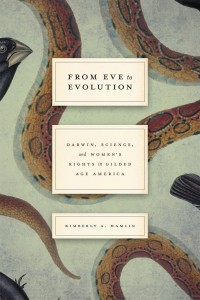Kimberly A. Hamlin. From Eve to Evolution: Darwin, Science, and Women’s Rights in Gilded Age America (Chicago University Press, 2014) 238 pages.
Review by Lilian Calles Barger
To address the eternal “woman question,” the emerging modern feminism of the Gilded Age turned to Charles Darwin for answers. In From Eve to Evolution, Kimberly A. Hamlin’s fascinating intellectual history uncovers how the new evolutionary science provided multiple arguments by which women advanced the cause of women’s rights and equality in the home and society. Most of us are familiar with the Enlightenment, religious, and socialist origins of feminist thought. Hamlin suggests another significant strand of thought offered by the science of human origins. She argues that Darwinism, often with varied and unorthodox interpretations, was effective in overturning a central ideological obstacle to women’s equality: the biblical story of Eve. Charles Darwin’s theory, against his own conservative masculinist views, turned traditional views of women upside down. Freethinkers, socialists, and sexologists seized on evolutionary science to build arguments against recalcitrant traditional views. They asserted that the culture of their age was an artificial construct of erroneous ideas and called for change in order to live in accordance with the evolutionary laws of nature. As what Hamlin calls “reform Darwinists,” her subjects stood against social Darwinism, religious teaching, and custom.
Yet, evolutionary science under male control was also deployed to reassert women’s subordination. Sex difference, as described by many male scientists, pointed to female intellectual inferiority. Women’s views, excluded from the newly professionalized science, depended on the evidence of “woman experience” against hardening interpretations of Darwin’s theories. Examining the books, articles, and journals of the period, and building on the secondary literature on the emergence of modern feminism and science, Hamlin offers a lucid narrative of how a group of women intervened in the period between the demise of a hegemonic and negative interpretation of Eve and the masculinist consolidation of evolutionary science.
In On the Origins of the Species, Darwin challenged religious teaching by placing humans within an organic animal-human continuum. The popular Descent of Man introduced the theory of “sex selection” which explained gender difference and reproduction. Together, these two books challenged “special creation” and the religious doctrines of divine origins. The Genesis story, as classically interpreted, placed the blame for the “Fall of Man” on Eve, which required woman’s subordination and the suffering of motherhood. Before  Darwin, the creation of Eve from Adam’s rib dominated thought on gender. The story shaped private and public life with its gender expectations and norms. Judith Sargent Murray, Sarah Grimke’s reinterpretation of Genesis, and Elizabeth Cady Stanton’s rewrite of the Bible all attempted to challenge the derivative tale of woman’s creation. By the end of the nineteenth century, Darwin’s theories offered a new avenue by which to dispute the reigning gender narrative and dispense with Eve altogether. Yet, Darwinist science was a political double-edged sword dividing the women’s rights movement. Religious conservatives could tie anti-evolution with anti–woman’s emancipation arguments. Others rallied to evolutionary theory to support the gender status quo as inevitable and to affirm biological determinism.
Darwin, the creation of Eve from Adam’s rib dominated thought on gender. The story shaped private and public life with its gender expectations and norms. Judith Sargent Murray, Sarah Grimke’s reinterpretation of Genesis, and Elizabeth Cady Stanton’s rewrite of the Bible all attempted to challenge the derivative tale of woman’s creation. By the end of the nineteenth century, Darwin’s theories offered a new avenue by which to dispute the reigning gender narrative and dispense with Eve altogether. Yet, Darwinist science was a political double-edged sword dividing the women’s rights movement. Religious conservatives could tie anti-evolution with anti–woman’s emancipation arguments. Others rallied to evolutionary theory to support the gender status quo as inevitable and to affirm biological determinism.
Feminist evolutionists seeking to forestall this development sought to cast gender difference as a strengths, rather than a “curse” or a weaknesses. Hamlin focuses on some notable women who advanced the evolution-based argument, including Maria Mitchell, Mary Putman Jacobi, and Antoinette Brown Blackwell. Evolutionary science greatly increased the interest in what Blackwell called the “science of feminine humanity” (60). Blackwell was convinced that evolutionary science was misinterpreted by “the most influential authorities in science today. … standing on a learned masculine eminence, looking from their isolated male standpoint through their men’s spectacles and through the misty atmosphere of entailed hereditary glamor” (62).
The answer was for women to engage science through the evidence of their experience and to reinterpret the evolutionary evidence for themselves. Menstruation, pregnancy, and lactation where explored to further the idea that all of these were normal, natural, and positive experiences rather than ones that rendered women weak and sickly. These women argued that the future progress of the race (meaning the white race) depended on the strength and fortitude of women. Women’s engagement with science—through education, reading, discussion, writing, and attempts to contribute to scientific research—brought new formulations of the meaning of difference.
Hamlin demonstrates the ways in which evolutionary theory was useful in establishing the legitimacy of working mothers and promoting change in parenting patterns. Women such as Blackwell (with five children), along with Marion Harland and Charlotte Perkins Gilman, also mothers with careers, argued that mothers who engaged in work outside the home would be of benefit to the race. They began with examples from the animal kingdom, as well as their own experience, and promoted the idea of improved domestic arrangements as a means to foster a strong, “fit pregnancy” (97). They repudiated the idea that motherhood foreclosed all other options for women. Helen Hamilton Garderner argued, “…nowhere in nature is the mere fact of sex—and that the race-producing sex—made a reason for fixed inequality of liberty, of subjugation, of subordination, and of determined inferiority of opportunity… Nowhere until we reach man” (105). Blackwell prioritized parenting in which men played an equal role in child rearing. In Women and Economics, Gilman’s application of evolutionary theory necessitated rethinking all domestic arrangement for the furtherance of human progress. In contrast, the Darwinian thinker Ellen Key proposed that because the future of the race depended on the strength of motherhood, women should devote their lives solely to it. Evolution was the “holiness of generation” (125). Regardless of their evolutionary formulations, they all rejected the Genesis interpretation of wifely subordination and the curse of pregnancy.
Evolutionary theory could support female superiority; since Darwin and the Bible showed the creation moving from lower-order animals to higher-level ones, the secondary creation of Eve placed her at the pinnacle of God’s creation and thus superior to man. Eliza Burt Gamble, convinced of the superiority of women, found scientific basis in the Darwinian concept of “female choice” in mating as the norm among all animals except humans (131). Gamble argued that female prerogative in mating required financial independence, made possible under socialism. The interlocking structures of capitalism and patriarchy kept women in a state of perpetual dependence. The frivolous fashions of the day, which emphasized female frailty and beauty, demonstrated the loss of female choice in mating. Hamlin also demonstrates how the primacy of female choice came to undergird Margaret Sanger’s birth-control movement and the arguments for female autonomy.
From Eve to Evolution applies a useful gender analysis to the history of Darwinian thought in America thus challenging feminist readings of Darwinian science as anti-feminist. Hamlin also has not evaded the raced-based arguments in much of her subjects’ writings. By focusing on the interconnections between religion, science, and gender, she has opened a broader spectrum and new areas for exploration, such as the response of African-American women to evolutionary theory. I would like to see broader analysis of the reason “the natural” was evoked at that time as authoritative, since humanity had fought against nature for millennia, as well as the relationship in the minds of Hamlin’s subjects between determinism and freedom. The ideas teased out by the author are still very much in play as the areas of science that focus on gender and the brain continue to offer findings and interpretations of gender differences, with pushback from both feminists and social constructionist. Hamlin makes an implicit contribution to the idea that difference may not be the problem but rather how society evaluated those differences in a hierarchy of values.
Lilian Calles Barger, (Ph.D. University of Texas at Dallas), is an independent scholar working in Taos, NM and serves on the book review committee of the Society. She is currently  working on a book manuscript entitled The World Come of Age: Religion, Intellectual and the Challenge of Human Liberation.
working on a book manuscript entitled The World Come of Age: Religion, Intellectual and the Challenge of Human Liberation.

0